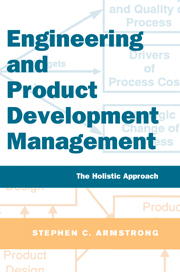Book contents
- Frontmatter
- Contents
- List of figures and tables
- Forewords
- Preface
- Acknowledgments
- Layout of book at a glance
- PART 1 UNDERSTANDING ENGINEERING PROCESS MANAGEMENT
- PART 2 APPLYING ENGINEERING PROCESSES TO PROGRAM MANAGEMENT
- PART 3 DEPLOYING ENGINEERING PROCESS MANAGEMENT
- PART 4 APPENDIXES
- A IPD maturity self-evaluation tools
- B Chapter 2 tables
- C Chapter 3 table
- D Pogram structuring and planning checklist
- E Chapter 8 tables
- F Understanding the ERP and the PDM connection
- Glossary
- References
- Index
D - Pogram structuring and planning checklist
Published online by Cambridge University Press: 05 April 2014
- Frontmatter
- Contents
- List of figures and tables
- Forewords
- Preface
- Acknowledgments
- Layout of book at a glance
- PART 1 UNDERSTANDING ENGINEERING PROCESS MANAGEMENT
- PART 2 APPLYING ENGINEERING PROCESSES TO PROGRAM MANAGEMENT
- PART 3 DEPLOYING ENGINEERING PROCESS MANAGEMENT
- PART 4 APPENDIXES
- A IPD maturity self-evaluation tools
- B Chapter 2 tables
- C Chapter 3 table
- D Pogram structuring and planning checklist
- E Chapter 8 tables
- F Understanding the ERP and the PDM connection
- Glossary
- References
- Index
Summary
D.1 PROGRAM SCOPE AND ENVIRONMENT CONFIRMATION
❍ Confirm program scope and objectives
➮ Review charter, proposal, and existing workplans
❍ Confirm cost and schedule constraints
➮ Use planning assumptions worksheet
❍ Confirm engineering and work practice guidelines
➮ Use planning assumptions worksheet
❍ Interview corporate executives
D.2 PROGRAM STRUCTURING
❍ Select and tailor subphases
➮ Use IPD process architecture diagram
❍ Select and tailor subphase objectives
➮ Use IPD subphase objectives chart and IPD workflow diagrams
❍ Determine customer deliverables
➮ Use subphase objectives chart
❍ Select and tailor customer deliverables sections
➮ Use deliverables definition worksheets and IPD workflow diagrams
❍ Determine key deliverables
➮ Use IPD workflow diagrams
❍ Identify CAD/CAE tools constraints
➮ Use program planning assumptions worksheet
❍ Select design techniques and tools
➮ Use program planning assumptions worksheet
❍ Select design hardware and software
➮ Use program planning assumptions worksheet
❍ Determine design standards and procedures
➮ Use program planning assumptions worksheet
❍ Determine replanning points and planning windows
➮ Use program planning assumptions worksheet
❍ Select program management techniques and tools
➮ Use program planning assumptions worksheet
❍ Determine program reporting procedures
➮ Use program planning assumptions worksheet
❍ Determine issue logging and resolution procedures
➮ Use program planning assumptions worksheet
❍ Perform risk assessment
➮ Use risk assessment questionnaire
❍ Determine strategies for managing risk
➮ Use risk management strategy tables
❍ Determine program risk assessment points
➮ Use life cycle checkpoints worksheet
❍ Tailor the IPD program review process
- Type
- Chapter
- Information
- Engineering and Product Development ManagementThe Holistic Approach, pp. 282 - 284Publisher: Cambridge University PressPrint publication year: 2001



